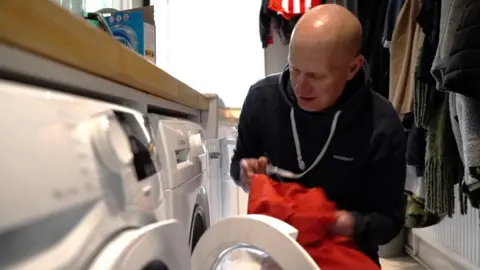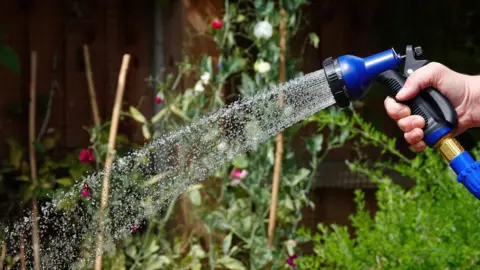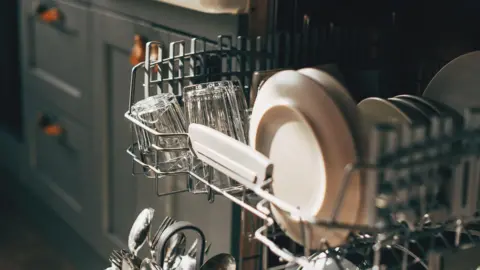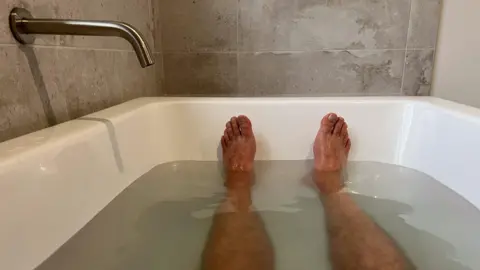How can I reduce my water usage?
 BBC
BBCI'm BBC South's environment correspondent and I have something to admit - I have no idea how much water I use each day.
Have you ever thought about your water usage? I mean, really thought about it?
From the washing to the cooking, the dishwasher to the hosepipe, the shower to the dog bowl.
A survey by Water UK found 46% of people thought their entire household used 20 litres (five gallons) of water a day.
But in reality, for the average household in the UK it's more than 500 litres (110 gallons).
Dr Julia Brown, associate professor in sustainable environmental management at the University of Portsmouth, thinks there's a lack of understanding across the UK.
"I think in this country our levels of water literacy are just chronically low," she said.
"I don't think it's necessarily our fault, I just think it's something we take for granted."
 Getty Images
Getty ImagesThe pressures on our water supplies in the south of England are ever-increasing.
New housing developments need supply and climate change is stressing our rivers and aquifers.
Even reading this article has an impact - computer servers need cooling and as artificial intelligence (AI) becomes more embedded in our daily lives, the internet is becoming increasingly thirsty.
Thames Water has been talking to the government about the challenges of water demand in relation to data centres and how it can be mitigated, the BBC understands.

While lately the spotlight has been on the amount of raw sewage going into our rivers and seas, Dr Brown says the focus should be more about reducing our water consumption.
The National Audit Office has recently predicted a five-billion-litre daily shortfall by 2050, based on current usage.
"There isn't a week that goes by where there isn't something in the media about waste water," Dr Brown says.
"And that's hugely important – I think we need to hold water companies to account undoubtedly.
"But we're losing sight of the fact that the more fresh water we use in our homes the more waste water we are putting into the system."
The average Southern Water household of four people uses about 160,000 litres (42,267 gallons) of water a year. Of that, 148,000 litres (39,097 gallons) is treated as waste.
Wet feet
In order to reduce the amount of water we use, we first need to work out our water footprint - that's how much we're using.
And when it comes to water, it turns out our feet have been changing size.
In the 1960s, average water consumption was 85 litres (22 gallons) a day per person. By 2002, that had increased to 155 litres (41 gallons).
Although the amount of water we use on average has fallen slightly, currently at around 139 litres (37 gallons), it's still higher than comparable countries like Germany.
 Getty Images
Getty ImagesTechnology is playing a part in reducing consumption with the advancement of eco programmes for dishwashers and washing machines.
But at 50 litres (13 gallons) on average per clothes wash, some are calling for us to reduce how often we clean our clothes.
In France, the government-backed organisation the Agency for Ecological Transition (ADEME) kicked up a stink by suggesting jeans could go 30 days before a wash, t-shirts could be worn five times and even gym kit could be worn three times before hitting the laundry bin.
Showering accounts for about 40% of the average household's daily water usage, according to Wessex Water.
And while a long hot shower may help de-stress, anything longer than 10 minutes will use more than the average bath.
As for baths, which on average use 80 litres (21 gallons) of water, every inch lower saves about 5 litres (1 gallon).
 Getty Images
Getty ImagesThe installation of water meters should make understanding how much we use per household more straightforward.
But measuring the impact we have on our water supplies is more complicated.
To accurately calculate my water footprint, I need to take into account not only what I use at home, but what I also buy.
It is known as "virtual water", an idea first originated by Prof Tony Allan, a geographer at King's College London.
Dr Brown says water is involved in producing most of the things we buy.
"So our household water footprint we can calculate by looking at what we do within the home," Dr Brown says.
"But we can also factor in, for example, the clothing we use and buy as well as particularly the food that we're consuming."
Food for thought
It turns out a lot of water goes into making our food.
A 200g (7oz) tray of tomatoes grown in a hot climate like Spain needs around 16 litres (4 gallons) of water.
Avocados can require anything between 140 litres (31 gallons) and 260 litres (57 gallons) each.
Meat such as grain-fed beef is even more water intense. A 250g (9oz) steak needs over 3700 litres (814 gallons) over the three years it takes to produce.
And it's not just food with a water footprint. Oxfam estimates one cotton t-shirt requires 2,700 litres of water to produce.
Leaks v leeks
While I'm learning there are lots of ways I can reduce how much water I use, there's one issue that all water company customers are only too aware of - leaks.
The question of: "Why am I trying to save water if it's already being wasted?" is one that surfaces every time.
According to figures released by the government, the national average of leaks across water companies in England between 2023 and 2024 was just under 46 litres (11 gallons) per person.
But as water companies in our region invest to make our supplies more resilient in the future, the bottom line is water is a finite resource.
And Dr Brown believes our attitudes to it must change.
"I think we're sleepwalking into this in many ways," she says.
"And I think we really need to be more mindful about our water, where it comes from, the impacts we're having locally and also globally as well."
Join us tonight on BBC One from 18:30 BST, when South Today will be live from the River Thames in Streatley, Berkshire, for a special programme about water.
You can follow BBC Hampshire & Isle of Wight on Facebook, X (Twitter), or Instagram.
